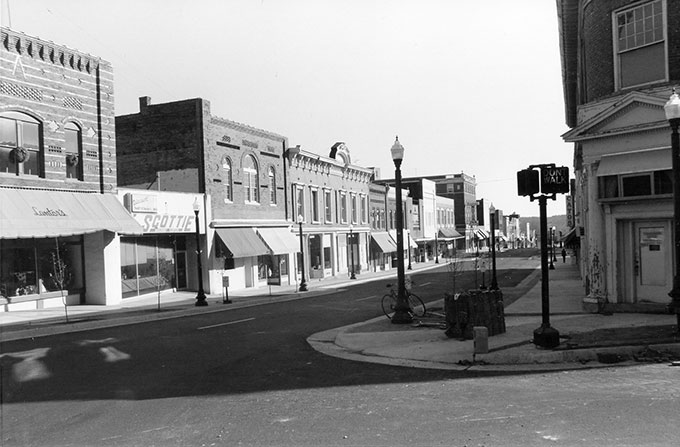
Ideas
Forgotten Architectures of Memory in a Small Town: South Boston, Virginia
“And instantly, he would see the towns below, now coiling in a thousand fumes of homely smoke, now winking into a thousand points of friendly light.” –Thomas Wolfe, The Web and the Rock
If Thomas Wolfe passed through South Boston on a train in the 1930’s, it would have been one of those towns that he saw from a train window winking into a thousand points of friendly light. South Boston has historically been associated with trade, especially as a market for tobacco and center for production of textiles. Much of the noteworthy architecture that has distinguished the town as a unique place was built with profits from tobacco and textiles.
Urban places with collective aspirations are open to change, and the Town of South Boston is undergoing steady and persistent change. When the town came into its own after the Civil War, it was due to the profitability of the tobacco and textile trades. As the town prospered through the late nineteenth and early twentieth centuries, many remarkable warehouses, stores, factories, and houses were constructed. After reaching a point of stasis in the late twentieth century, the town began a slow decline in population and income that continues into the present. From my own experience visiting my grandparents and extended family in South Boston in the 1960’s, 70’s, and 80’s and later from visiting my parents who retired to the town, the decline became noticeable and disturbing in the late 1990’s and 00’s and frightening in the second decade of the twenty-first century.
In 2013, the tobacco market and the textile factories are long gone. The trade in tobacco and textiles were significant to the extent that the town achieved two distinctions that remain remarkable: by 1907, South Boston had the second largest bright leaf tobacco market in the United States (1), and the Halifax Damask Mill located in the town patented and produced the iconic red-checked damask used for tablecloths (2). Today, along the streets of South Boston, many buildings and structures remain as testaments to the town’s two distinctions. Over time, however, fewer and fewer of these structures remain, and with the destruction of each old building or structure, the memories of South Boston’s historical essence disappear.
One can easily dismiss the decline and disappearance of historical artifacts in a small Virginian town as simply inevitable. However, the current conditions and trends that affect South Boston are affecting small towns throughout the United States. As Aldo Rossi suggests, we should understand urban artifacts as works of art. From his assertion, one assumes that art is worth preserving, if not in fact, at least in memory.
Rossi writes:
The question of the city as a work of art, however, presents itself explicitly and scientifically above all in relation to the conception of the nature of collective artifacts, and I maintain that no urban research can ignore this aspect of the problem. How are collective urban artifacts related to works of art? All great manifestations of social life have in common with the work of art the fact that they are born in unconscious life. This life is collective in the former, individual in the latter; but this is only a secondary difference because one is a product of the public and the other is for the public: the public provides the common denominator. (3)
With Rossi’s assertions in mind, a visit to South Boston today will focus one’s attention on numerous unsettling facts and images: huge empty lots where once thriving warehouses existed; a smoke stack that stands alone in a field; empty lots in residential neighborhoods where houses once stood; and empty store fronts. If the trends that create these facts and images continue unchecked, where will be the future one thousand points of friendly light that shine from the towns of Virginia and the United States? In Rossi’s terms, the public is no longer a common denominator in an economic and social equation where the resultant is the destruction of any urban community. To extend Wolfe’s metaphor, will towns become so amorphous and deconstructed that their lights become indistinguishable from the general glare of post-industrial America?
Below are a few images of South Boston today that illustrate the destruction of the collective memory that creates the town:
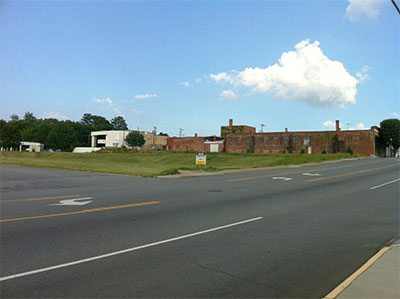
[1] Empty lot along Wilborn Avenue where a warehouse once stood
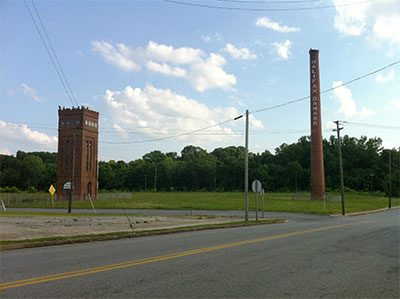
[2] Empty lot where Halifax Damask Mill once stood.
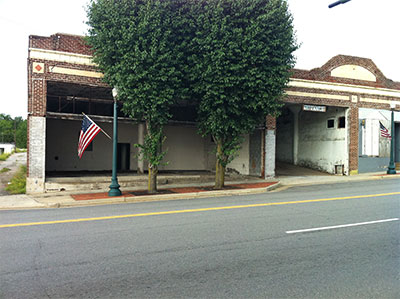
[3] Abandoned storefront where Crowell Motor Company was once located.
In the case of the first photograph, which is the empty lot once occupied by a tobacco warehouse, one sees a huge green field with commercial buildings in the background. Unintentional fields do not belong in an urban place. The warehouse that once existed was masonry and heavy timber. During an active market day, one could enter the warehouse and see rows of baskets filled with cured tobacco, and one could smell the tobacco even outside of the warehouse walls. Auctioneers walked along the rows of tobacco with buyers following close by. These sensory experiences are history and will be forgotten with no artifact to attest their existence. In the late 1990’s the warehouse burned and was destroyed. Since the tobacco market was already in a state of decline, the warehouse was never rebuilt.
When the warehouse existed, its brick façade created a formidable wall that defined the street front and anchored the section of the town’s commercial district where tobacco warehouses were concentrated. Below is a photo from the early 1990’s before the warehouse’s destruction:
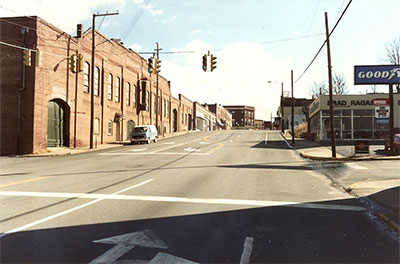
As an architect with memories of an earlier and more vibrant South Boston, I cannot suppress the desire to see architecture return to the empty lot of the warehouse, to see the solitary smokestack become related again to some useful building, and to see empty, disintegrating stores be rejuvenated and purposeful. I believe that my aspirations to see architecture fill South Boston’s urban voids align with the aspirations of the town’s people. The town has naturally shifted and changed in response to nature and economic imperatives, but as an architect, my desire is to show how the collective memory of a town can be preserved and stand in contrast to the animosities of decay and forgotten history while constructing new buildings and structures that are useful.
Footnotes
1. “South Boston, Virginia: Historic District Walking Tour, First South Boston Chartered in 1796”, Citing Source. Last modification unknown. Accessed 14 April 2013. http://www.oldhalifax.com/county/SBWalkingTourHistory.htm Adapt.ed from the original hard copy publication created by the Halifax County Chamber of Commerce Tourism Committee.
2. “South Boston, Virginia: Historic District Walking Tour, no. 26: 1205 Washington Avenue. Last modification unknown. Accessed 14 April 2013.
http://www.oldhalifax.com/county/SBWalkingTour26.htm. Adapted from the original hard copy publication created by the Halifax County Chamber of Commerce Tourism Committee.
3. Rossi, Aldo. The Architecture of the City. Cambridge, Massachusetts: The MIT Press, 1982. pp. 32-33. Print.

Architecture died between the black and the white: I wrote this statement while in my first year of studying architecture at Virginia Tech. Until now, I have never bothered to explain what the statement means.
Architectural design requires a messy method. Buildings, building interiors, and designed objects do not arise in a pristine environment of pure reason on the one hand or pure ideology on the other. Architecture arises from human consciousness which is developed out of experience (history) and recognition of what could be (future). History and future are themselves a black and white dichotomy, and if either has complete control of consciousness, the effect is nothingness and inertia that precludes the act of design. So the present act of design must find itself between the historical and the futuristic. True innovation arises from the knowledge of the past and the acknowledgement of future desires.
The architecture of Square-P® lies between the black and the white. Square-P® represents design where actions respond to the usefulness of memory, the demands of current circumstance, and the hope of the future.
